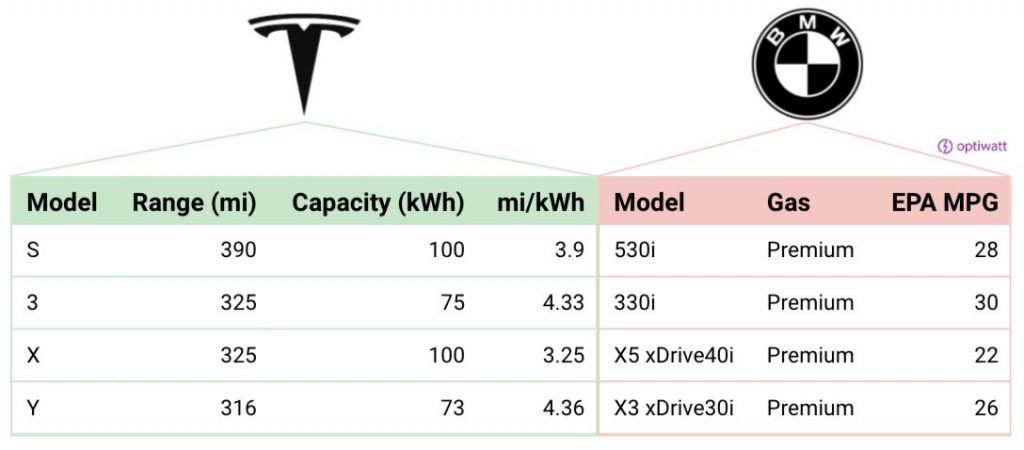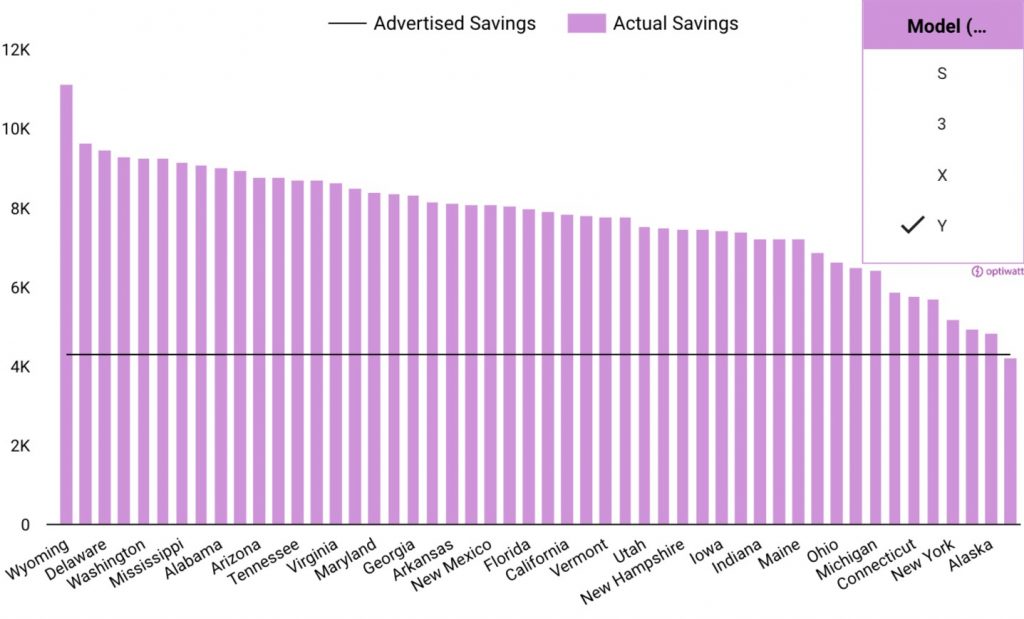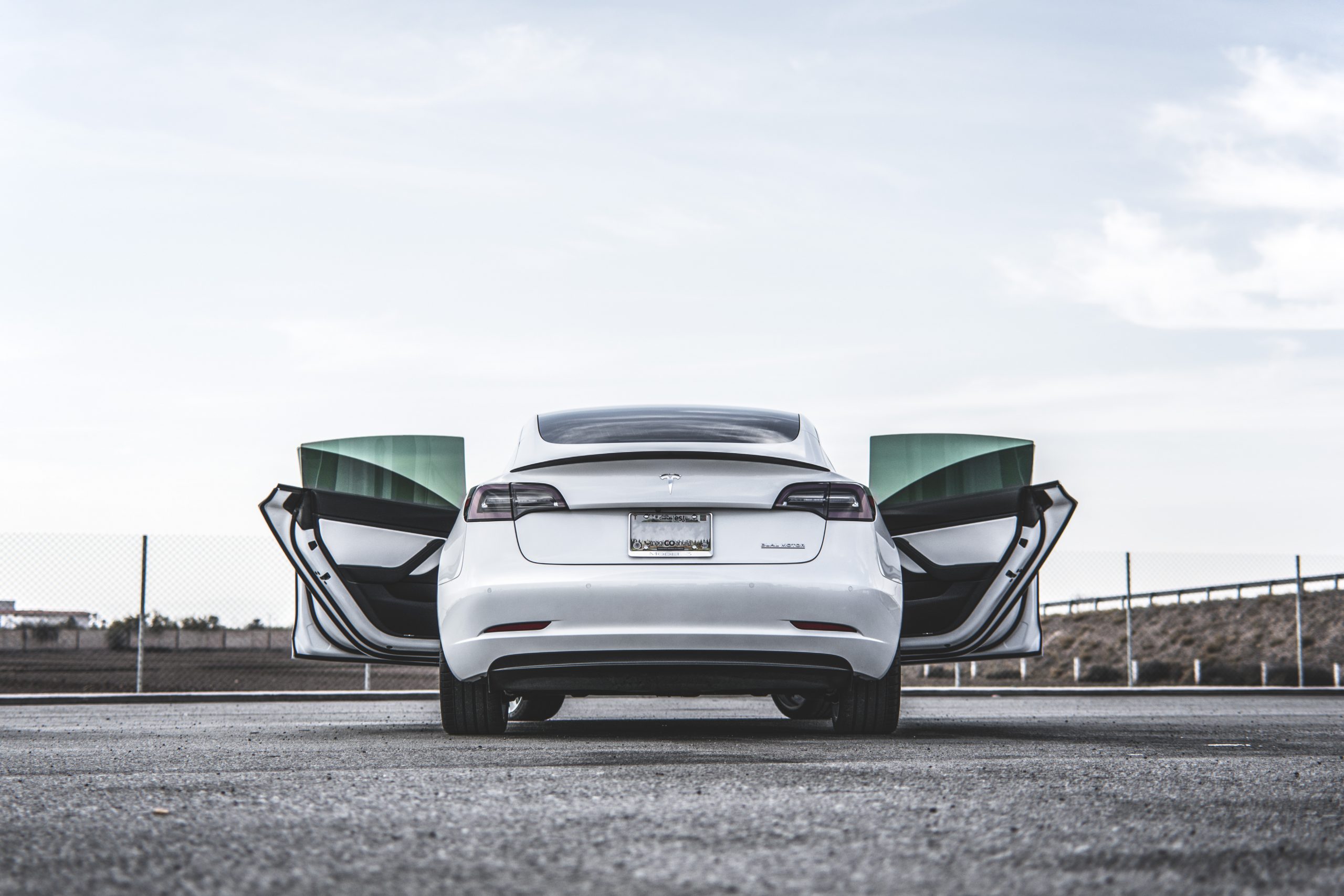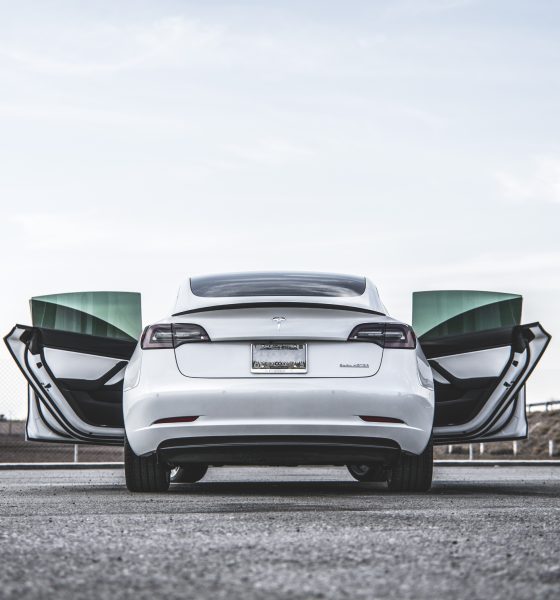Tesla’s online configurator for its electric cars primarily shows a price that’s adjusted for incentives and estimated fuel savings. These savings vary depending on the vehicle being ordered, with the company listing estimated gas savings of $4,300 for the Model 3 and Model Y, $5,300 for the Model X, and $5,500 for the Model S. These may seem like optimistic estimates, but as it turns out, these figures are actually conservative, at least for the majority of the United States.
Tesla’s fuel savings estimate is based on the premise that charging an all-electric vehicle is a lot more affordable than filling up the tank of a petrol-powered car. Looking at the company’s estimates, it appears that the listed fuel savings for the Model S, 3, X, and Y are based on the assumption that drivers would drive their Tesla for 10,000 miles annually for a period of six years. The costs of charging a Tesla over this period is then compared to the estimated costs of refueling a comparable vehicle, such as a BMW, with premium gasoline.
This strategy actually makes sense, considering that the all-electric construction of a Tesla will likely allow the vehicle to be used for at least six years. The comparison with BMW’s vehicles is quite sound as well, seeing as both companies offer premium cars that perform and compete in the same segment. That being said, EV charging rate monitoring service Optiwatt noted in a recent report that Tesla’s estimated gas savings are a lot more nuanced than what the company’s online configurator would suggest.

If there is one area where Tesla could be faulted, it is in the way that its estimated fuel savings for the US are the same regardless of the state where the car is being purchased. Different states have different electricity and average fuel prices, which means that there are some places where Tesla drivers could save more than the company’s own estimates, and areas where the opposite will be accurate. Take Hawaii, for example. The state pays 32 cents per kWh of electricity, which is over three times higher than the 9 cents per kWh that are paid by residents in Oklahoma.
Fuel consumption varies across states as well, with drivers in rural areas consuming more petrol and drivers in high-density states like New York consuming less. Wyoming drivers buy the most gas per capita at 609 gallons per person per year, while New York purchases less than half at 292 gallons per person per year. Considering that Tesla’s fuel savings rely on the price discrepancy between electricity and gas, owners who drive more are more likely to meet the company’s fuel savings estimates compared to owners who drive less.

Optiwatt’s analysis notes that ultimately, there are some areas in the United States where owning a Tesla will save drivers far more than what the company’s estimates would suggest, and there are some areas where fuel savings will be underwhelming. Driving a Model Y in Rhode Island for 10,000 miles every year for six years will save owners about $4,235 in fuel costs, which is a bit less than the company’s $4,300 estimate. Driving the all-electric crossover in Wyoming for six years, on the other hand, will give owners fuel savings of $11,122, over two times the company’s estimates.
A look at Optiwatt’s data shows that Tesla’s newer vehicles like the Model 3 and Model Y are more likely to meet the company’s fuel savings estimates, despite the Model S and Model X’s free Supercharging capabilities. Yet on average, across Tesla’s vehicle lineup, it appears that Americans can expect to save about $2,500 more than the company’s estimated savings over a six-year period. This bodes well for electric cars and their economic appeal as a whole. After all, a Tesla is not just designed to run for 6 years. With the company’s million-mile batteries poised to be released soon, Tesla drivers over the years will likely see even more fuel savings for every electric car purchase.

News
Tesla FSD fleet is nearing 7 billion total miles, including 2.5 billion city miles
As can be seen on Tesla’s official FSD webpage, vehicles equipped with the system have now navigated over 6.99 billion miles.

Tesla’s Full Self-Driving (Supervised) fleet is closing in on almost 7 billion total miles driven, as per data posted by the company on its official FSD webpage.
These figures hint at the massive scale of data fueling Tesla’s rapid FSD improvements, which have been quite notable as of late.
FSD mileage milestones
As can be seen on Tesla’s official FSD webpage, vehicles equipped with the system have now navigated over 6.99 billion miles. Tesla owner and avid FSD tester Whole Mars Catalog also shared a screenshot indicating that from the nearly 7 billion miles traveled by the FSD fleet, more than 2.5 billion miles were driven inside cities.
City miles are particularly valuable for complex urban scenarios like unprotected turns, pedestrian interactions, and traffic lights. This is also the difference-maker for FSD, as only complex solutions, such as Waymo’s self-driving taxis, operate similarly on inner-city streets. And even then, incidents such as the San Francisco blackouts have proven challenging for sensor-rich vehicles like Waymos.
Tesla’s data edge
Tesla has a number of advantages in the autonomous vehicle sector, one of which is the size of its fleet and the number of vehicles training FSD on real-world roads. Tesla’s nearly 7 billion FSD miles then allow the company to roll out updates that make its vehicles behave like they are being driven by experienced drivers, even if they are operating on their own.
So notable are Tesla’s improvements to FSD that NVIDIA Director of Robotics Jim Fan, after experiencing FSD v14, noted that the system is the first AI that passes what he described as a “Physical Turing Test.”
“Despite knowing exactly how robot learning works, I still find it magical watching the steering wheel turn by itself. First it feels surreal, next it becomes routine. Then, like the smartphone, taking it away actively hurts. This is how humanity gets rewired and glued to god-like technologies,” Fan wrote in a post on X.
News
Tesla starts showing how FSD will change lives in Europe
Local officials tested the system on narrow country roads and were impressed by FSD’s smooth, human-like driving, with some calling the service a game-changer for everyday life in areas that are far from urban centers.

Tesla has launched Europe’s first public shuttle service using Full Self-Driving (Supervised) in the rural Eifelkreis Bitburg-Prüm region of Germany, demonstrating how the technology can restore independence and mobility for people who struggle with limited transport options.
Local officials tested the system on narrow country roads and were impressed by FSD’s smooth, human-like driving, with some calling the service a game-changer for everyday life in areas that are far from urban centers.
Officials see real impact on rural residents
Arzfeld Mayor Johannes Kuhl and District Administrator Andreas Kruppert personally tested the Tesla shuttle service. This allowed them to see just how well FSD navigated winding lanes and rural roads confidently. Kruppert said, “Autonomous driving sounds like science fiction to many, but we simply see here that it works totally well in rural regions too.” Kuhl, for his part, also noted that FSD “feels like a very experienced driver.”
The pilot complements the area’s “Citizen Bus” program, which provides on-demand rides for elderly residents who can no longer drive themselves. Tesla Europe shared a video of a demonstration of the service, highlighting how FSD gives people their freedom back, even in places where public transport is not as prevalent.
What the Ministry for Economic Affairs and Transport says
Rhineland-Palatinate’s Minister Daniela Schmitt supported the project, praising the collaboration that made this “first of its kind in Europe” possible. As per the ministry, the rural rollout for the service shows FSD’s potential beyond major cities, and it delivers tangible benefits like grocery runs, doctor visits, and social connections for isolated residents.
“Reliable and flexible mobility is especially vital in rural areas. With the launch of a shuttle service using self-driving vehicles (FSD supervised) by Tesla in the Eifelkreis Bitburg-Prüm, an innovative pilot project is now getting underway that complements local community bus services. It is the first project of its kind in Europe.
“The result is a real gain for rural mobility: greater accessibility, more flexibility and tangible benefits for everyday life. A strong signal for innovation, cooperation and future-oriented mobility beyond urban centers,” the ministry wrote in a LinkedIn post.
News
Tesla China quietly posts Robotaxi-related job listing
Tesla China is currently seeking a Low Voltage Electrical Engineer to work on circuit board design for the company’s autonomous vehicles.

Tesla has posted a new job listing in Shanghai explicitly tied to its Robotaxi program, fueling speculation that the company is preparing to launch its dedicated autonomous ride-hailing service in China.
As noted in the listing, Tesla China is currently seeking a Low Voltage Electrical Engineer to work on circuit board design for the company’s autonomous vehicles.
Robotaxi-specific role
The listing, which was shared on social media platform X by industry watcher @tslaming, suggested that Tesla China is looking to fill the role urgently. The job listing itself specifically mentions that the person hired for the role will be working on the Low Voltage Hardware team, which would design the circuit boards that would serve as the nervous system of the Robotaxi.
Key tasks for the role, as indicated in the job listing, include collaboration with PCB layout, firmware, mechanical, program management, and validation teams, among other responsibilities. The role is based in Shanghai.
China Robotaxi launch
China represents a massive potential market for robotaxis, with its dense urban centers and supportive policies in select cities. Tesla has limited permission to roll out FSD in the country, though despite this, its vehicles have been hailed as among the best in the market when it comes to autonomous features. So far, at least, it appears that China supports Tesla’s FSD and Robotaxi rollout.
This was hinted at in November, when Tesla brought the Cybercab to the 8th China International Import Expo (CIIE) in Shanghai, marking the first time that the autonomous two-seater was brought to the Asia-Pacific region. The vehicle, despite not having a release date in China, received a significant amount of interest among the event’s attendees.










